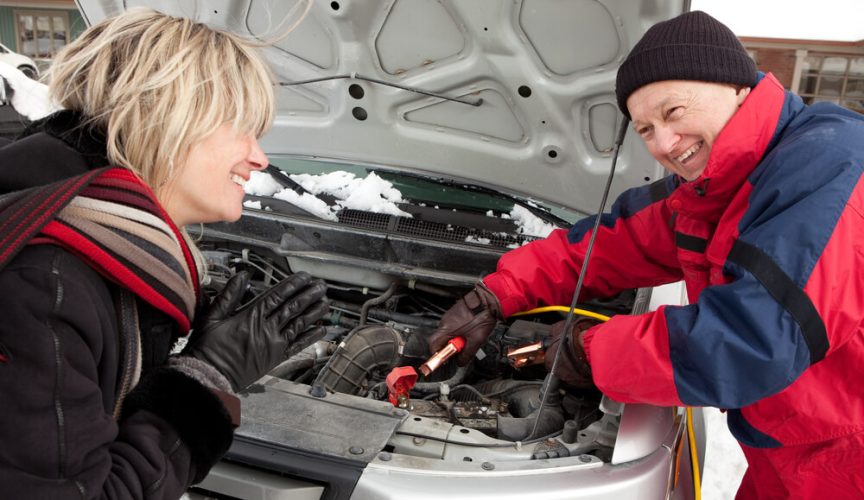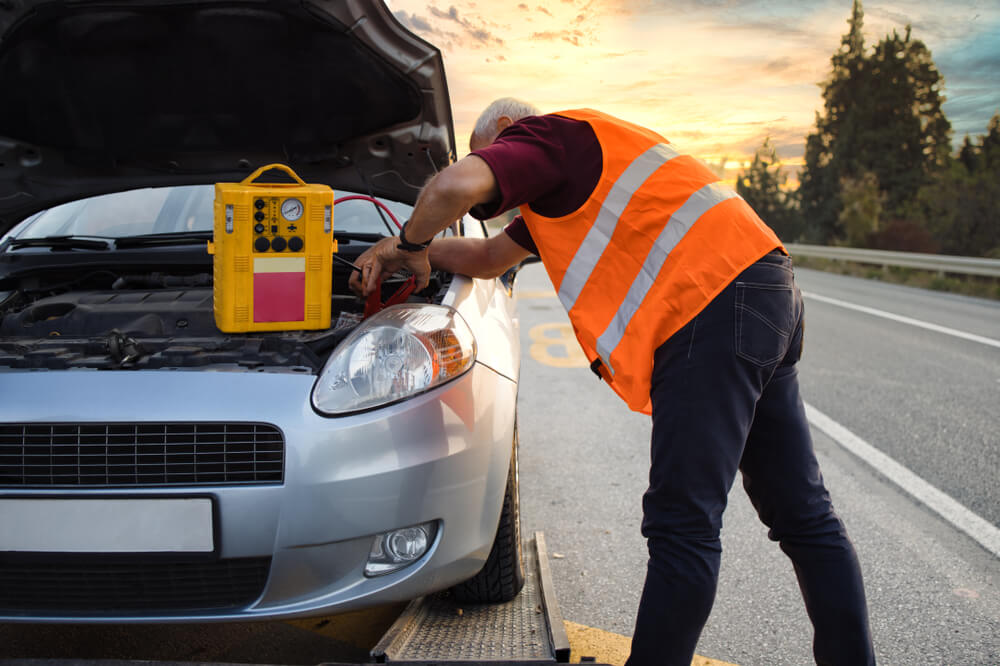
A dead car battery is never a welcomed surprise. Whether you’re rushing to work or stranded in a parking lot, it always seems to happen at the worst time. The good news is that knowing how to jump-start a car safely can get you back on the road quickly. If you’re unsure about the process, Freeway Auto Club offers roadside assistance to get you back on the road quickly and safely.
While jump-starting a car is straightforward, taking the right precautions ensures a safe and successful start. The next section details the process, helping you avoid common mistakes and potential hazards.
Safety First: Jump-Starting Without the Jitters
Before popping the hood to jump-start a car, take a moment to assess your surroundings. Park on level ground, engage the parking brake, and turn off the ignition.
If you’re on the roadside, switch on your hazard lights to alert other drivers. Wearing safety gloves and glasses isn’t required, but it’s a good precaution. Electricity and metal demand careful handling, and car batteries contain sulfuric acid, which can be harmful if it contacts your skin or eyes.
Here are a few ground rules:
- Avoid Flames and Sparks. Keep cigarettes, open flames, and other ignition sources away from the battery. It can release hydrogen gas, which is highly flammable.
- Keep Metal Objects Away. Tools, jewelry, or anything metallic should be kept clear of the battery.
- Check for Unusual Odors. A rotten egg smell could signal a sulfuric acid leak. If you notice this, do not attempt to jump-start the car—call for assistance.
- Inspect the Battery. If you see cracks, leaks, or damage, do not proceed. Seek professional help.
- Examine the Jumper Cables. Ensure they are free of frayed wiring, corrosion, or other damage before use.
- Know Your Vehicle. Review your owner’s manual, as some vehicles have specific jump-starting instructions that differ from standard procedures.
Preparing to Jump-Start Your Car
You’ll need another vehicle with a functioning battery and a set of jumper cables. If you don’t have cables, ask someone who knows how to jumpstart a car safely for help or call roadside assistance.
Before connecting anything, make sure:
- Both cars are in park (or neutral if using a manual transmission) with the ignitions off.
- The jumper cables are untangled and in good condition
- The battery terminals are free from corrosion. If there’s corrosion buildup, clean it with a rag or wire brush.
- Make sure the voltage of both batteries matches. Most vehicles have 12-volt batteries, but some older or specialized models may differ.
The Step-by-Step Jump-Start Process
Now, let’s go step by step on how to connect jumper cables properly:
- Attach the red (positive +) clamp to the dead battery’s positive terminal.
- Connect the other red (positive +) clamp to the positive terminal of the working battery.
- Attach the black (negative -) clamp to the working battery’s negative terminal.
- Connect the other black (negative -) clamp to an unpainted metal surface on the dead car’s engine block—never directly to the negative battery terminal. This helps prevent sparks near the battery.
- Start the car with the working battery. Let it run for about five minutes to send power to the dead battery.
- Try to start the car with the dead battery. If it turns over, let it idle for several minutes.
- Carefully remove the jumper cables in the reverse order:
- Black clamp from the metal surface
- Black clamp from the working battery
- Red clamp from the working battery
- Red clamp from the revived battery
Leave the car running for at least 15 minutes to allow the alternator to recharge the battery. If the vehicle doesn’t start after several attempts, the battery may be beyond saving, and it is time for a replacement.

Other things to consider after a jump-start:
- If your battery is more than three years old, it might be time for a replacement.
- Check your alternator. If your battery keeps dying, the issue could be with the charging system, not the battery itself.
- Look at your car’s electrical system. Sometimes, a bad relay or parasitic drain can cause a battery to die repeatedly.
- Remember there are many simple vehicle maintenance tasks you can do yourself to help avoid ending up with a dead battery in the first place.
After the Jump: Next Steps
Once your car is running, hitting the road immediately is tempting— but hold on. Drive for at least 20–30 minutes to ensure the battery holds a charge. Short trips won’t give it enough time to recharge, and you might end up in the same situation the next time you turn off the engine.
If the car struggles to start again soon after, consider getting the battery tested. Most auto parts stores will do this for free. A weak battery or faulty alternator could be the real culprit.
Troubleshooting Jump-Start Issues
If you’ve correctly followed the steps on jump-starting a car safely and the car still won’t start, consider these common issues:
- Are the connections secure? Loose clamps can prevent a proper charge.
- Is the dead battery too far gone? It may need replacing if it’s old, corroded, or has been completely drained for too long.
- Does the donor battery have enough power? If it is weak, it may not provide enough charge to jump a car successfully.
- Is the alternator functioning? If the battery keeps draining, the alternator may not be recharging it properly.
- Are the cables in good condition? Frayed or damaged cables may not conduct electricity properly.
- Is the ignition system functioning? A faulty starter or ignition switch can prevent the car from starting, even with a charged battery.
If none of these solutions work, it’s time to call for professional help. In some cases, a jump-start won’t be enough, and a roadside assistance plan will soon prove it is worth it if it is the safest and quickest solution.
Don’t Want to Worry About Jumper Cables? Sign Up for Freeway Auto Club and Get Roadside Assistance
A dead battery can ruin your day, but you don’t have to deal with it alone. Freeway Auto Club offers roadside assistance, including jump-starts, towing, and more—anytime, anywhere.
Freeway Insurance has been helping drivers find affordable coverage for decades. Whether you need auto, home, or renters insurance, we connect you with policies that fit your budget. Call 800-777-5620 or visit us online to get a free quote!



